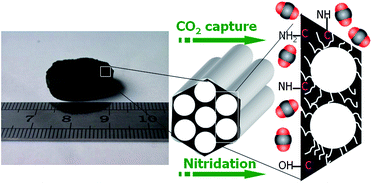Ordered mesoporous carbons: citric acid-catalyzed synthesis, nitrogen doping and CO2 capture
Abstract
Ordered mesoporous carbon materials (OMCs) were synthesized with the use of

* Corresponding authors
a
Institute of New Catalytic Materials Science, Key Laboratory of Advanced Energy Materials Chemistry (Ministry of Education), College of Chemistry, Nankai University, Tianjin, China
E-mail:
zyyuan@nankai.edu.cn
Fax: +86 22 2350 9610
Tel: +86 22 2350 9610
Ordered mesoporous carbon materials (OMCs) were synthesized with the use of

 Please wait while we load your content...
Something went wrong. Try again?
Please wait while we load your content...
Something went wrong. Try again?
L. Liu, Q. Deng, T. Ma, X. Lin, X. Hou, Y. Liu and Z. Yuan, J. Mater. Chem., 2011, 21, 16001 DOI: 10.1039/C1JM12887F
To request permission to reproduce material from this article, please go to the Copyright Clearance Center request page.
If you are an author contributing to an RSC publication, you do not need to request permission provided correct acknowledgement is given.
If you are the author of this article, you do not need to request permission to reproduce figures and diagrams provided correct acknowledgement is given. If you want to reproduce the whole article in a third-party publication (excluding your thesis/dissertation for which permission is not required) please go to the Copyright Clearance Center request page.
Read more about how to correctly acknowledge RSC content.
 Fetching data from CrossRef.
Fetching data from CrossRef.
This may take some time to load.
Loading related content
